Managers Corner
The goal of the manager’s corner is to help managers make informed decisions through sharing science, research, and its applications from the HJ Andrews Experimental Forest. To this end, we provide management-relevant synopses of research publications with key words to help manager’s search for topics of interest.
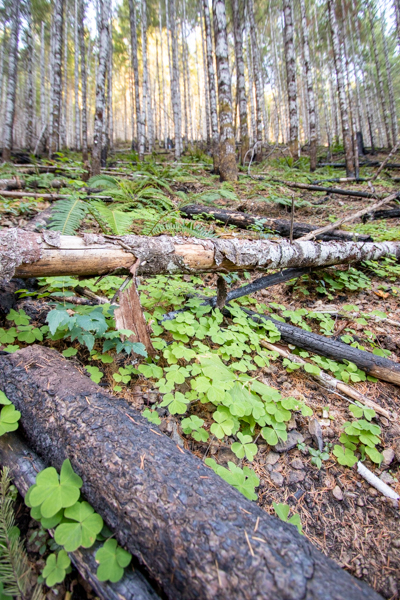 Burn severity and pre-fire seral state interact to shape vegetation responses to fire in a young, western Cascade Range forest
Burn severity and pre-fire seral state interact to shape vegetation responses to fire in a young, western Cascade Range forest
Do young forests respond to fire differently than older forests? Does pre-fire seral stage impact species richness and diversity during recovery? The authors investigated the response of understory plants to fire in a previously logged forest. They measured species composition, richness, diversity, and evenness before and after a controlled burn. The authors described changes for early-seral annuals and perennials and for forest generalists, which are mainly shade-tolerant shrubs. Keywords: early seral, fire severity, forest understory, functional group, seral state, species diversity. Download PDF.
 Spatial and Temporal Patterns in Atmospheric Deposition of Dissolved Organic Carbon
Spatial and Temporal Patterns in Atmospheric Deposition of Dissolved Organic Carbon
How are terrestrial carbon and atmospheric carbon related to deposition of dissolved organic carbon? What is the role of atmospheric deposition in terrestrial carbon cycling globally? Are there spatial or temporal patterns in the deposition of dissolved organic carbon (DOC)? The researchers examined data collected for at least one year at 70 sites ranging from 40° S to 66° N. They evaluated seasonal and interannual patterns, whether patterns differed with latitude, and the relationships between DOC deposition and precipitation and between DOC deposition and potential sources of atmospheric carbon. Keywords: dissolved organic carbon, atmospheric deposition, terrestrial carbon influx, precipitation chemistry, carbon cycling, global synthesis. Download PDF.
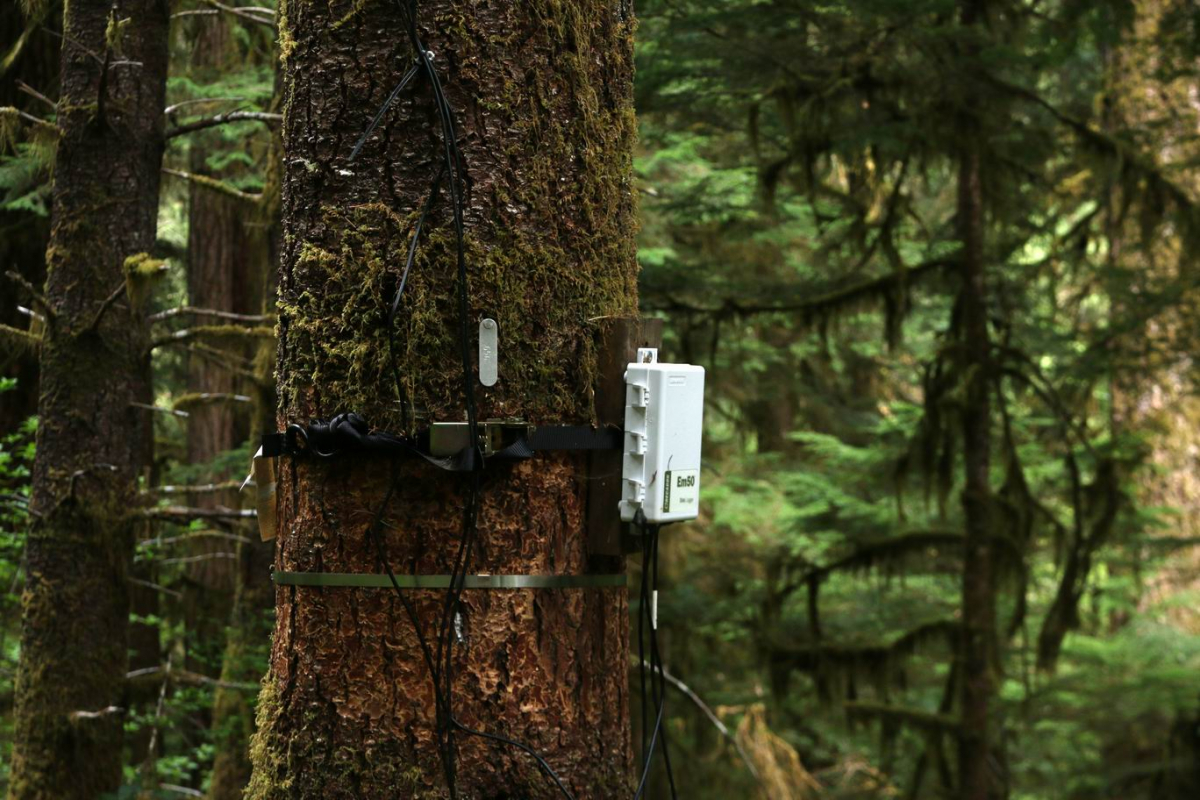 Canopy wetting patterns and the determinants of dry season dewfall in an old growth Douglas-fir canopy
Canopy wetting patterns and the determinants of dry season dewfall in an old growth Douglas-fir canopy
How does the weather, including frost and wetting from rain and dew influence the microclimates in forest canopies? The researchers used direct measurements over the vertical range of a 65-m Douglas fir tree over 4 years and a meteorological station over 15 years to determine how water inputs, drying cycles, and tree complexity influence canopy microclimates over years and across seasons. They also used their data to test two models, the Penman equation and a logistic model trained on in-tree data, which are intended to predict seasonal dewfall. Keywords: canopy microclimate, surface wetting, rainfall interception, dew, dewfall prediction, frost. Download PDF.
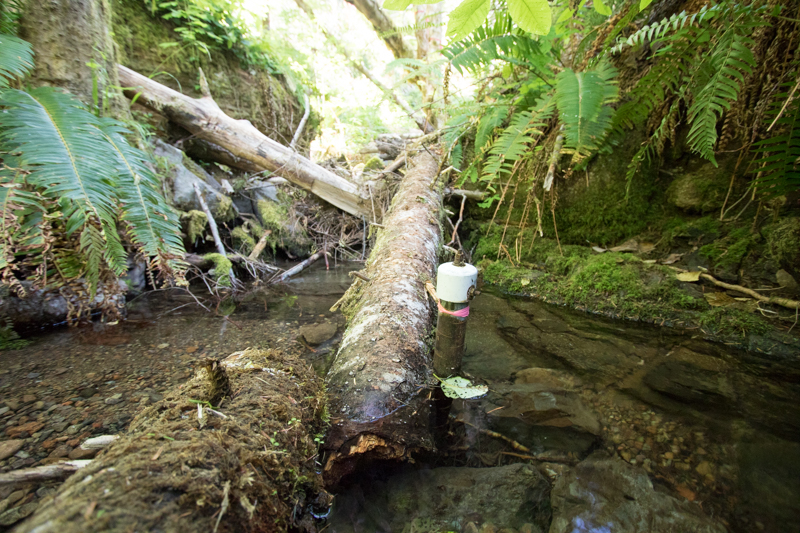 Testing hidden assumptions of representativeness in reach-scale studies of hyporheic exchange
Testing hidden assumptions of representativeness in reach-scale studies of hyporheic exchange
Does water movement and exchange measured and modeled for a specific reach allow inference across an entire stream segment? The authors investigated whether the hyporheic exchange determined over a study reach of tens to hundreds of meters in length could be assumed to be representative of water movement over segments hundreds to thousands of meters long. They asked whether water movement metrics vary with location in the basin and segment measurement strategy, and whether these metrics vary more within a stream segment than among stream segments with differing geology. Keywords: hyporheic exchange, stream segment sampling, representativeness, representative sampling, stream hydrology, hydrology modeling, reach length sampling strategy. Download PDF.
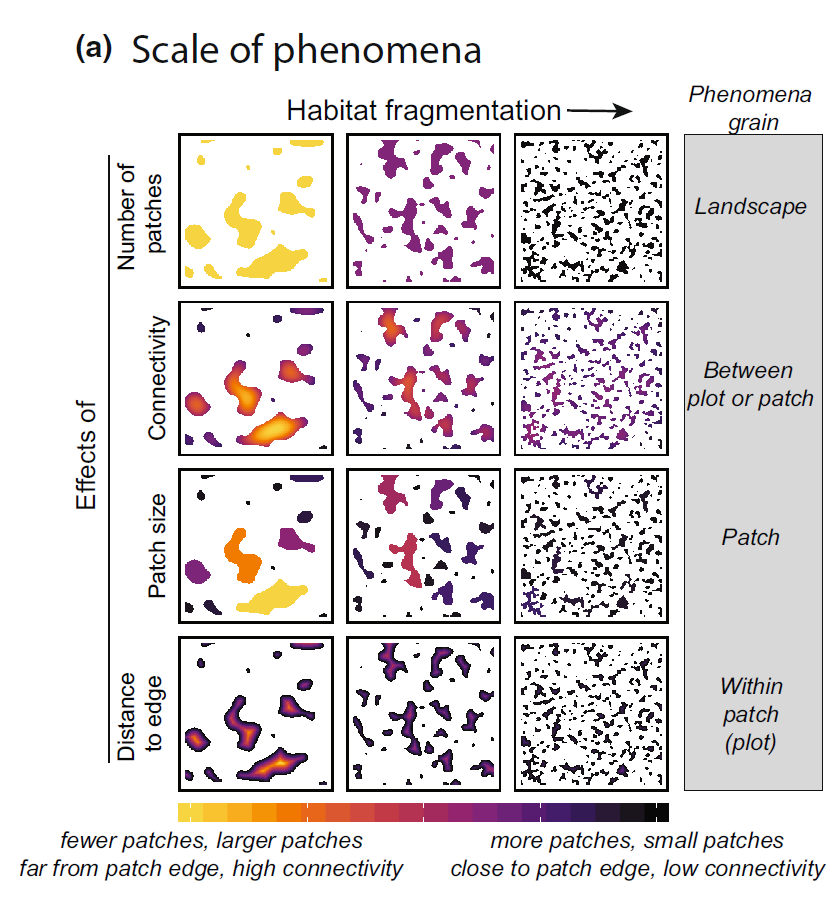 Addressing the problem of scale that emerges with habitat fragmentation
Addressing the problem of scale that emerges with habitat fragmentation
Where habitat fragmentation occurs, does the scale of sampling and analysis affect the resultant predictions, inferences, and extrapolations? How can researchers best identify and describe affects of habitat fragmentation at the plot, patch, and landscape scales? The authors explore the ways in which differences in scale among phenomena, sampling, and analysis can impact the studies of habitat fragmentation where habitat loss is constant. Additionally, they evaluate different sampling and analysis approaches to address research questions at various scales. Keywords: connectivity, edge, fragmented landscape, habitat loss, MAUP, patch size. Download PDF.
 Context matters: Natural tree mortality can lead to neighbor growth release or suppression
Context matters: Natural tree mortality can lead to neighbor growth release or suppression
What is the effect on nearby trees in a natural, unmanaged forest when a dominant tree dies? If a tree was a competitor to its neighbors, its death opens up resources and the neighbors’ growth rates should increase. If a tree was a facilitator, its death may lead to a slower growth rate for surviving neighbors. The authors investigate whether tree mortality leads to growth release or suppression in nearest neighbor trees using a 40-year data set from permanent plots on Mt. Rainier. Keywords: Abies, competition, facilitation, growth release, Mt. Ranier, permanent plot, primary forest, Pseudostuga, suppression, thinning, tree mortality. Download PDF.
 Wildfire in western Oregon increases stream temperatures, benthic biofilms, and juvenile coastal cutthroat trout size and densities with mixed effects on adult trout and coastal giant salamanders
Wildfire in western Oregon increases stream temperatures, benthic biofilms, and juvenile coastal cutthroat trout size and densities with mixed effects on adult trout and coastal giant salamanders
What is the effect of fire on stream ecosystems? How do populations of fish and other vertebrates respond after fire events? The authors used a before after control impact (BACI) study to evaluate two hypotheses one-year post-fire. The first is that increased stream temperature resulting from loss of riparian cover leads to decreases in population sizes. The second is that increased light availability results in increased primary productivity, which meets increased metabolic costs, and results in population stability or increase. Keywords: wildfire, stream temperature, benthic chlorophyll α, Pacific giant salamander (Dicamptodon tenebrosus), coastal cutthroat trout (Oncorhynchus clarkii clarkii). Download PDF.
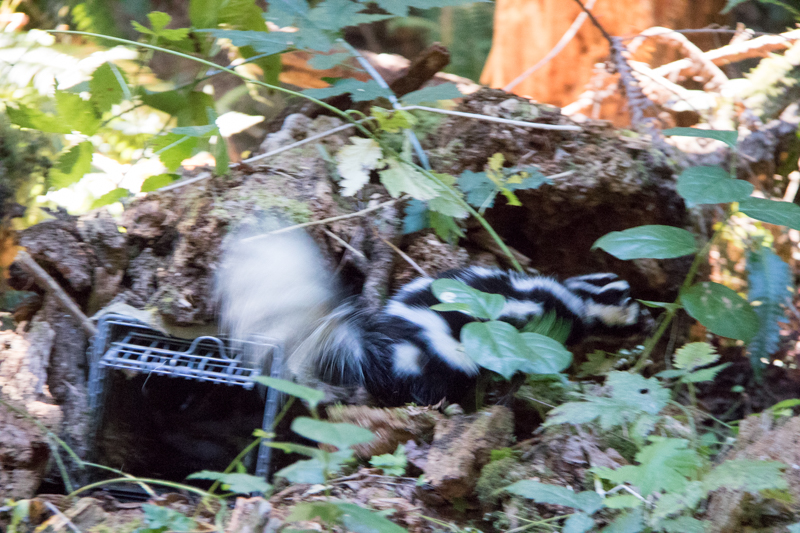 Multi-locus DNA metabarcoding reveals seasonality of foraging ecology of western spotted skunks in the Pacific Northwest
Multi-locus DNA metabarcoding reveals seasonality of foraging ecology of western spotted skunks in the Pacific Northwest
What is the dietary ecology of western spotted skunks? How does their diet change seasonally, and does it differ with land use? In this study, researchers identified prey species in scat using mechanical sorting and DNA metabarcoding. They aimed to comprehensively analyze diet both seasonally and in relation to land use category. By more fully understanding western spotted skunk diet, the researchers sought to illuminate the ecological role the skunks play in Pacific Northwest forests. Keywords: diet, DNA metabarcoding, generalist predator, land-use change, small carnivore, Spilogale gracilis. Download PDF.
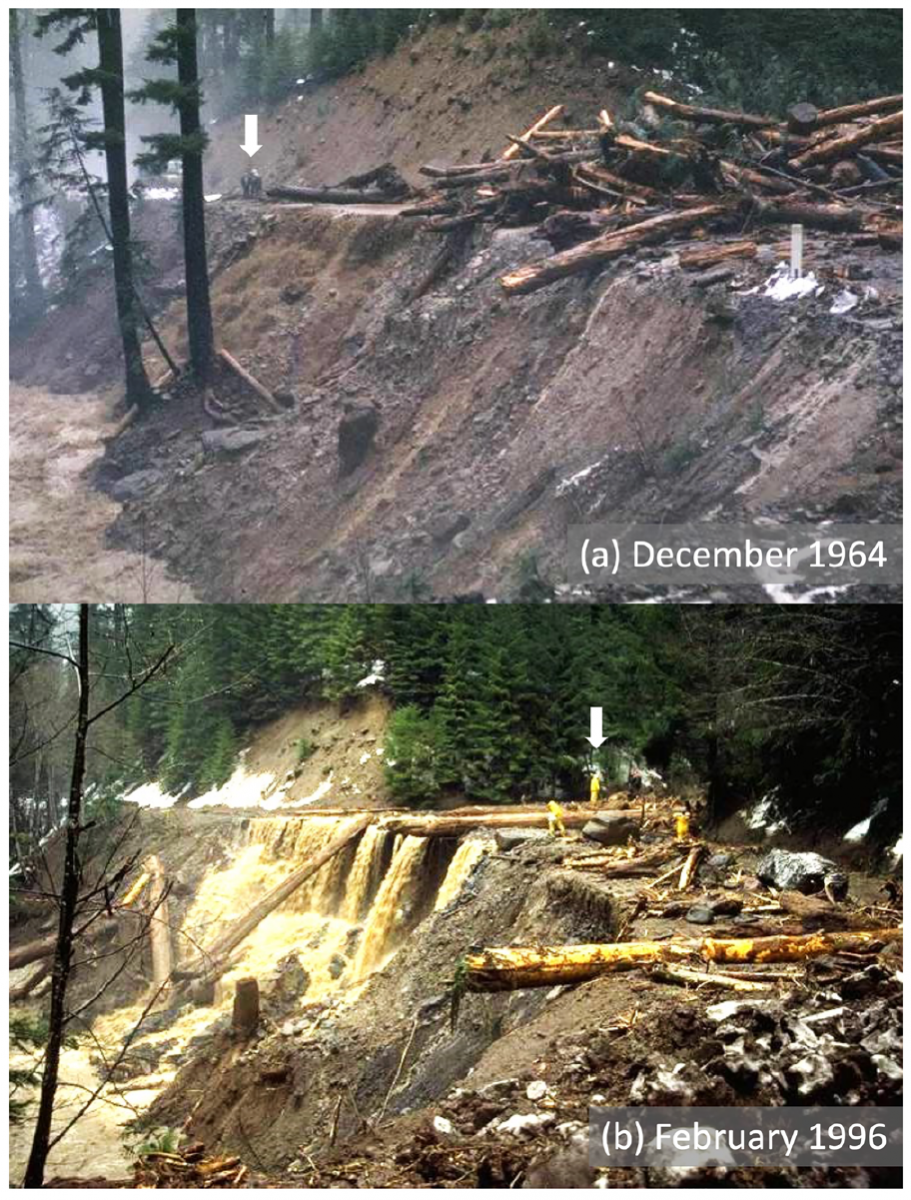 Seventy years of watershed response to floods and changing forestry practices in western Oregon, USA
Seventy years of watershed response to floods and changing forestry practices in western Oregon, USA
What are the watershed and stream reach level responses to forestry practices, flooding, and geomorphic change? Do these responses differ over five time periods associated with specific harvest practices or flood events? Scientists surveyed in four reaches of Lookout Creek, a steep, forested watershed in the H.J. Andrews Forest on the west slope of the Cascade Range in Oregon. Data were collected on scouring or aggradation, woody debris influx or efflux, and reworked channel area. Keywords: channel adjustment, disturbance cascade, harvesting, large wood, process domains, sediment supply, stochastic forcing, long-term harvest and flood data, road building. Download PDF.
 Forest degradation drives widespread avian habitat and population declines
Forest degradation drives widespread avian habitat and population declines
Is the type of forest habitat more important for bird populations than just forest cover? Does forest management for harvest impact bird species populations even with no net loss in the amount of forest cover? In this study the authors test whether forest degradation, simplification of forest composition and age-class truncation caused by logging and replanting cycles, drives habitat loss and population decline in forest-associated bird species. They used species-specific habitat estimates and breeding bird population surveys to determine the amount of forest degradation and whether this degradation was associated with population declines. Keywords: conservation biology, forest ecology, biodiversity, avian habitat, avian population decline, forest degradation. Download PDF.
 Crown closure affects endophytic leaf mycobiome compositional dynamics over time in Pseudotsuga menziesii var. menziesii
Crown closure affects endophytic leaf mycobiome compositional dynamics over time in Pseudotsuga menziesii var. menziesii
Tree canopies are home to communities of fungi that grow into the tree needle tissue without causing disease. Theses fungal communities can modulate nutrient uptake, stomatal conductance, and foliar disease severity. Research at the landscape and regional scales has shown that microclimate can impact variation in fungal community composition. The authors set out to determine how fungal community composition and diversity varied vertically in eight trees canopies using LiDAR to describe canopy closure, a measure of exposure level. Keywords: Nothophaeocryptopus, Rhabdocline, fungi, endosphere, old-growth, community ecology, ITS, metabarcoding, airborne LiDAR. Download PDF.
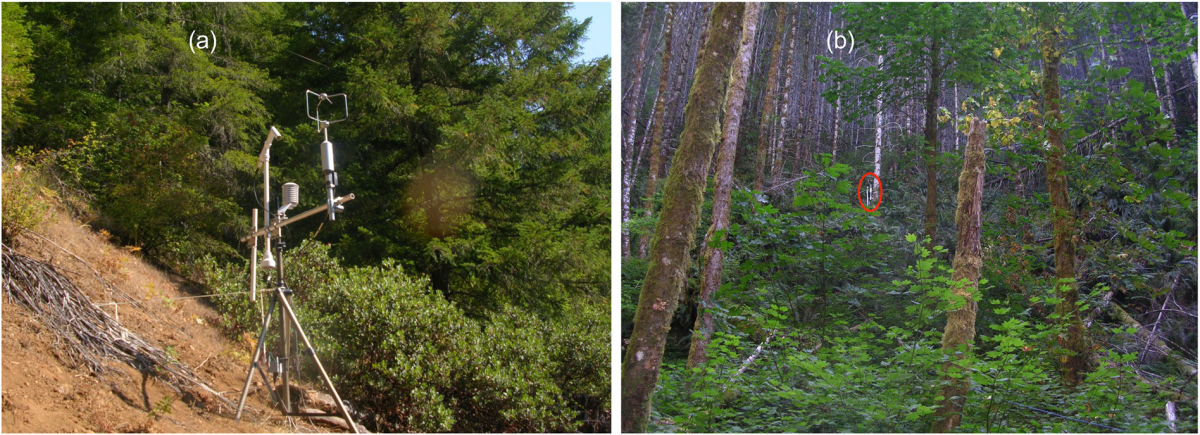 Increasing daytime stability enhances downslope moisture transport in the subcanopy of an even-aged conifer forest in Western Oregon, USA
Increasing daytime stability enhances downslope moisture transport in the subcanopy of an even-aged conifer forest in Western Oregon, USA
Do summer temperatures affect moisture and heat movement in, out, and within forest canopies and subcanopies? Researchers examined how the transport of moisture and heat into, out of, and within a forest subcanopy were influenced by summertime heating of the upper canopy. They measured moisture concentration, heat, and airflow. This study focused on a plantation forest in a steep mountain valley, which the authors considered to be representative of many Pacific Northwest managed forests. Keywords: subcanopy heat transport, subcanopy moisture transport, subcanopy airflow subcanopy inversions, static stability, regional climate change, downslope airflow, water vapor advection, water vapor transpiration. Download PDF.
 Carbon uptake by Douglas-fir is more sensitive to increased temperature and vapor pressure deficit than reduced rainfall in the western Cascade Mountains, Oregon, USA
Carbon uptake by Douglas-fir is more sensitive to increased temperature and vapor pressure deficit than reduced rainfall in the western Cascade Mountains, Oregon, USA
Do different kinds of drought have different impacts on western forests? How do different aspects of drought affect Douglas-fir trees in the Oregon Cascade Range? The authors examined how transpiration, gross primary productivity, and soil water availability were affected by a) atmospheric drought, increased summer temperature and vapor pressure deficit (VPD) with unchanged rainfall, and b) soil drought, decreased spring and summer rainfall with unchanged temperature and VPD. The authors also investigated the interactive effects of increased VPD and decreased rainfall on primary productivity and transpiration. Keywords: gross primary productivity, transpiration, vapor pressure deficit, Douglas-fir, soil-plant-atmosphere model, climate change response. Download PDF.
 Extreme drought conditions increase variability of nitrate through a stream network, with limited influence on the spatial patterns of stream phosphate
Extreme drought conditions increase variability of nitrate through a stream network, with limited influence on the spatial patterns of stream phosphate
Are nitrate and phosphate availability affected by drought conditions in western North American stream networks? The authors investigated spatial and temporal differences in nitrate and phosphate in three sections of the McRae stream network in the HJ Andrews experimental forest, Oregon. They sampled nutrient concentrations at 233 locations over 11.5 km during three time periods during varying levels of drought in 2015 and 2016. The researchers examined whether changing flow regimes and increased drought expected with changing climate conditions would alter nutrient transport and availability throughout the basin. Keywords: Nitrogen, Phosphorous, stream network, semi-variance analysis, drought, stream spatial patterns, H.J. Andrews. Download PDF.
 Long-term ecological research on climate ecosystem responses to climate change
Long-term ecological research on climate ecosystem responses to climate change
How should we think about climate change impacting ecosystem processes on a large scale spatially and temporally? Climate change impacts ecosystems over large areas and long time-scales. The authors use long term environmental research to create a conceptual framework for assessing how ecosystems respond to climate change and how these responses may differ among ecosystem types, among geographic settings or climatic characteristics, and across ecosystem processes. They discuss the invisible present – the time scale of the impact of our actions, the invisible place – the spatial scale of ecosystem events and processes, and spatiotemporal disturbance dynamics. Keywords: environmental forcing, extreme climate events, LTER Network, US National Science Foundation, human activities, ecosystem services. Download PDF.
 Diversity beyond demographics: Environmental worldviews of forestry and natural resource undergraduate students
Diversity beyond demographics: Environmental worldviews of forestry and natural resource undergraduate students
How diverse are the worldviews of undergraduate students in the natural resources? Is worldview another facet of diversity to foster? Over time the demographic diversity in the natural resources has increased and academic institutions often desire to further increase diversity in these fields. A diversity of perspectives and beliefs is expected to be achieved through establishing a demographically diverse student body. However, there has been no direct evaluation of the perspectives and beliefs of students in natural resource fields. In this study, the authors investigate the environmental worldview, as they termed it, of undergraduate students in forestry and other natural resource majors. Keywords: diversity, environmental worldviews, ethics, humanities, natural resources education. Download PDF.
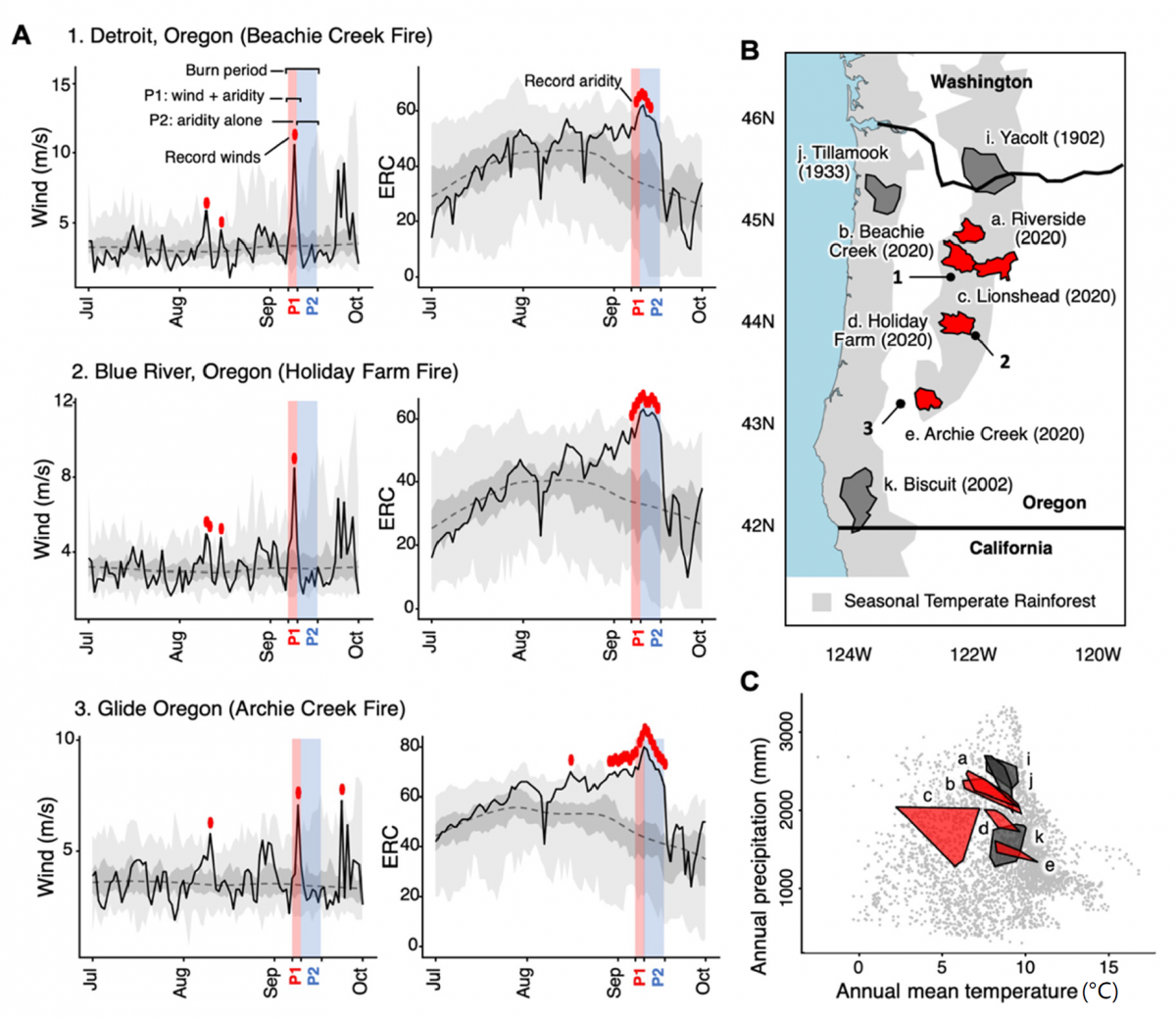 Extreme winds alter influence of fuels and topography on megafire burn severity in seasonal temperate rainforests under record fuel aridity
Extreme winds alter influence of fuels and topography on megafire burn severity in seasonal temperate rainforests under record fuel aridity
Can Oregon’s 2020 Labor Day wildfires help us understand how different factors influence how megafires affect temperate rainforests? Pacific northwest rainforests have historically had long periods between large wildfires and therefore, there is no consensus around how forests may respond to wildfires and how management practices may affect wildfire severity. Five megafires started within the western hemlock zone of Oregon’s temperate rainforest on Labor Day 2020. The authors analyzed these fires to determine patterns in burn severity in relation to winds and landscape conditions, two factors that may be impacted by a warming climate. Keywords: wildfire, Oregon 2020 fires, Labor Day fires, western Cascades, high-severity fire, climate-limited fire regime. Download PDF.
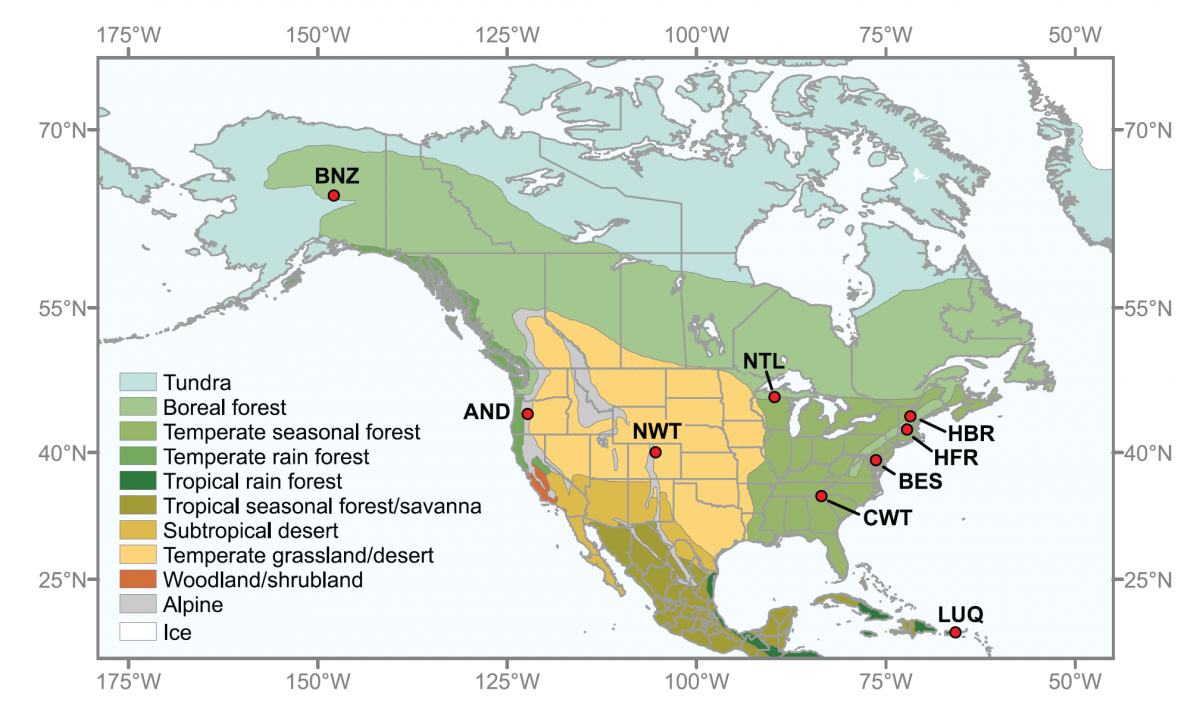 Forest and Freshwater Ecosystem Responses to Climate Change and Variability at US LTER Sites
Forest and Freshwater Ecosystem Responses to Climate Change and Variability at US LTER Sites
How and to what degree do forest and freshwater ecosystems respond to climate change? Freshwater systems provide services humans rely on as well as impacting associated forest systems through soil wetness and water availability. Climate change influences freshwater and forest systems because mean temperatures rise through time and because extreme weather events become more common. This study uses data from long term ecological monitoring sites with forest and freshwater components to determine the type and level of climate change and the ecosystem responses across a range of geographic zones. Keywords: stream, lake, climate change, ecosystem services, LTER. Download PDF.
 Forest microclimate and composition mediate long-term trends of breeding bird populations
Forest microclimate and composition mediate long-term trends of breeding bird populations
Can old growth forest stands buffer the impacts of climate change on migratory bird populations? Researchers investigated this question by testing two hypotheses over an eight-year period. 1) Does old growth forest provide cooler microclimates, which were more suitable for bird species’ physiological limits? 2) Does the more complex composition and structure of old growth stands dampen the effect of warmer temperatures, possibly through later or more prolonged prey availability? Keywords: biodiversity conservation, climate refugia, forest ecosystem, global warming, H.J. Andrews Experimental Forest, long-term ecological research, old-growth forests, redundancy hypothesis, bird breeding population trends, forest microclimates. Download PDF.
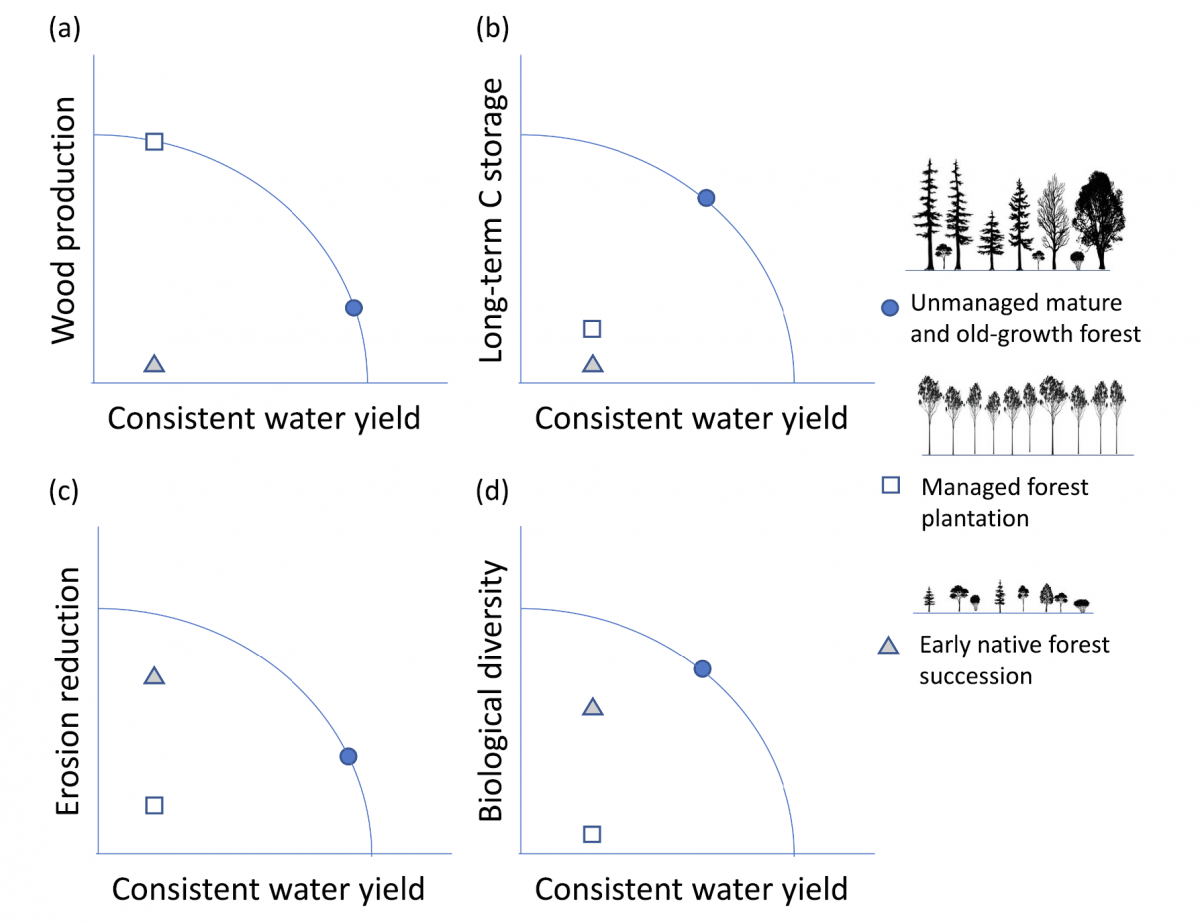 Forest restoration and hydrology
Forest restoration and hydrology
How does forest restoration impact ecosystem services, including hydrologic processes? A significant proportion of global forestland has been converted to alternate uses and many restoration projects are undertaken each year to increase forest cover, habitat, and ecosystem services. Different restoration goals and management approaches have differing impacts on forest system hydrology and water services. This review paper is designed to provide a conceptual framework, summarize current knowledge on how restoration impacts hydrology, and determine the effects of restoration type on water storage and cycling as well as tradeoffs between management goals and hydrology changes. Keywords: mature and old growth forests, native forest restoration, managed forest plantations, practical forest restoration approaches, tradeoffs among multiple objectives. Download PDF.
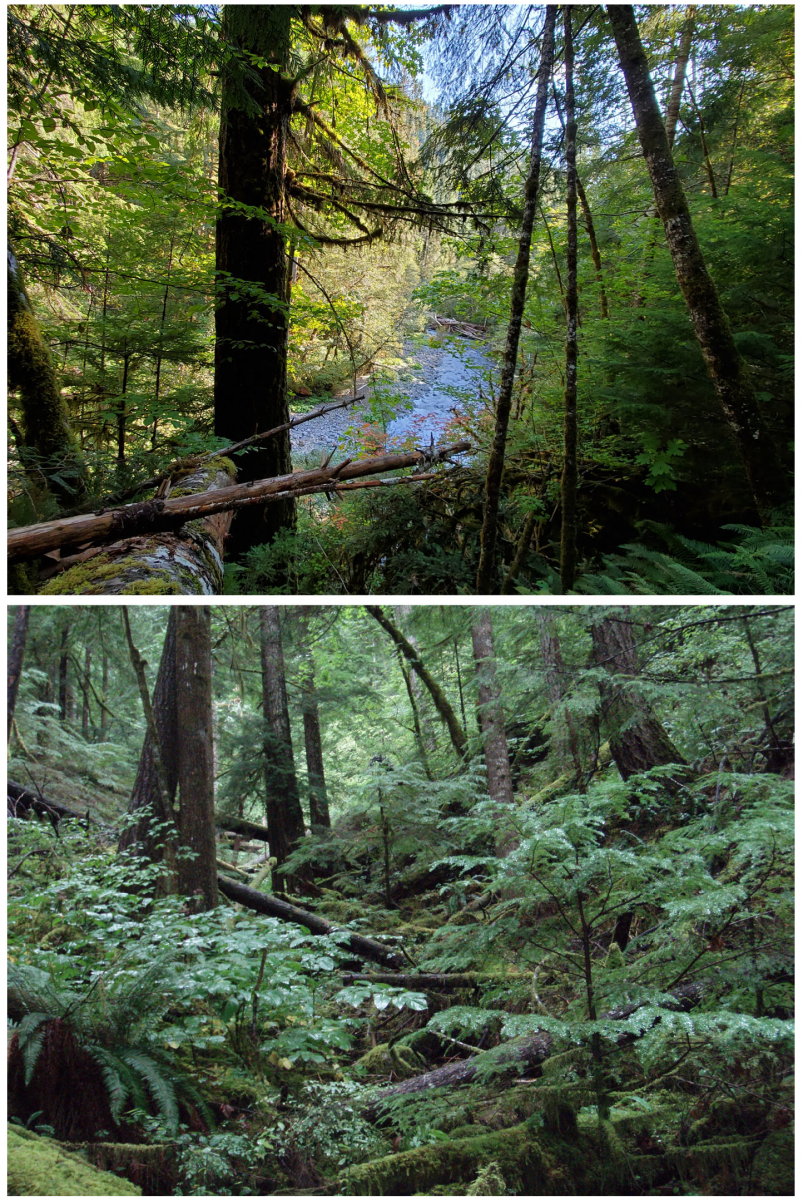 Long-term hydrology and aquatic biogeochemistry data from H. J. Andrews Experimental Forest, Cascade Mountains, Oregon
Long-term hydrology and aquatic biogeochemistry data from H. J. Andrews Experimental Forest, Cascade Mountains, Oregon
Have you ever wondered what happens in the HJ Andrews Experimental Forest and whether you can access the data? What types of research have been conducted in HJA? What is the installation history of environmental research gauges in land and stream locations in the H. J. Andrews Research Forest (HJA)? Did data collection procedures differ during different research periods and across environmental conditions? Are there existing long-term, publicly-available datasets and associated metadata? Hydrology research had been ongoing for 70 years at the time of publication. Keywords: long-term data, precipitation chemistry, research catchments, small watersheds, stream chemistry, stream discharge, hydrologic climate effects, nutrient cycling, nutrient dynamics, harvest and reference watersheds. Download PDF.
 Long-term ecological research and the COVID-19 anthropause: A window to understanding social-ecological disturbance
Long-term ecological research and the COVID-19 anthropause: A window to understanding social-ecological disturbance
How did human interactions with ecosystems change during the COVID-19 pandemic and what is an anthropause? Human activities impact ecosystems relatively consistently. Human responses to COVID-19 caused the level of impact on land, water, and atmosphere to change abruptly. This period has been termed an anthropause and has provided a period of comparison with which to examine human impacts on natural systems on a global scale. Human interactions with natural systems changed during the pandemic and whether patterns of impact return to pre-pandemic levels or stabilize at a different level is unresolved. Keywords: ecosystems, feedback, LTER, press, pulse, recovery, reorganization, resilience. Download PDF.
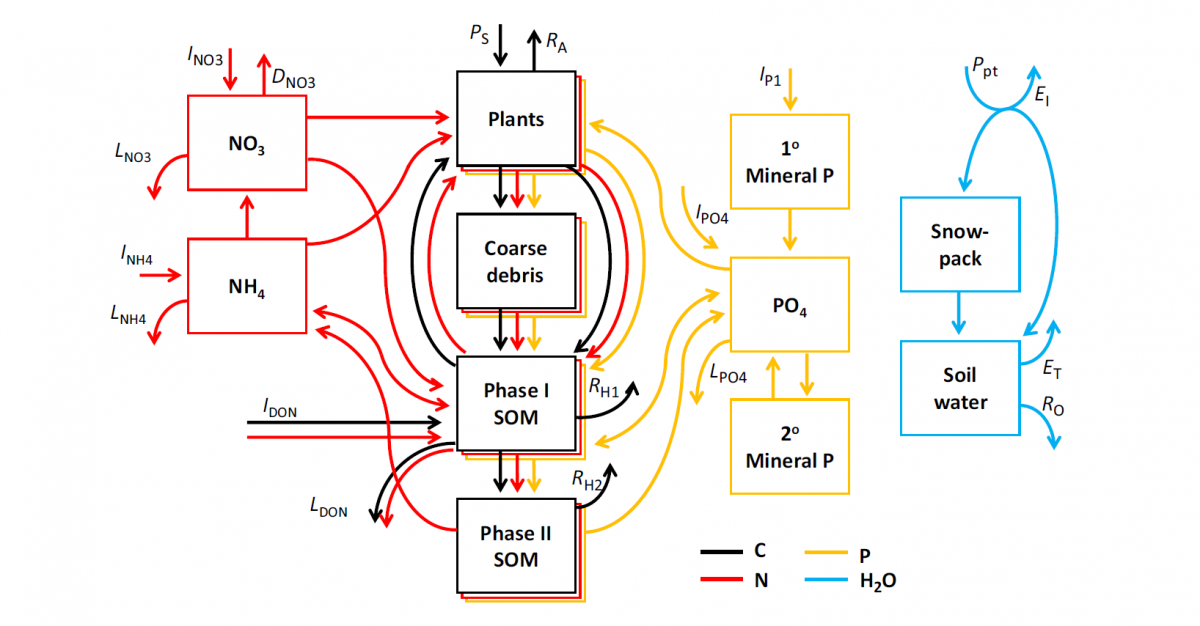 N and P constrain C in ecosystems under climate change: Role of nutrient redistribution, accumulation, and stoichiometry
N and P constrain C in ecosystems under climate change: Role of nutrient redistribution, accumulation, and stoichiometry
Cycling, distribution, and throughput of C, N, P, and water will influence how an ecosystem responds to symptoms of climate change, such as changing CO2, temperature, and precipitation. The researchers used a multiple element limitation (MEL) model to assess differences in response among 12 ecosystems. This approach incorporates standardized perturbations and provides a framework to attribute model responses to ecosystem and climate differences rather than to climate perturbations. Keywords: carbon dioxide fertilization, carbon sequestration, carbon-nitrogen interactions, carbon-phosphorus interactions, climate change, long-term ecological research (LTER), nitrogen cycle, phosphorus cycle, terrestrial ecosystem stoichiometry. Download PDF.
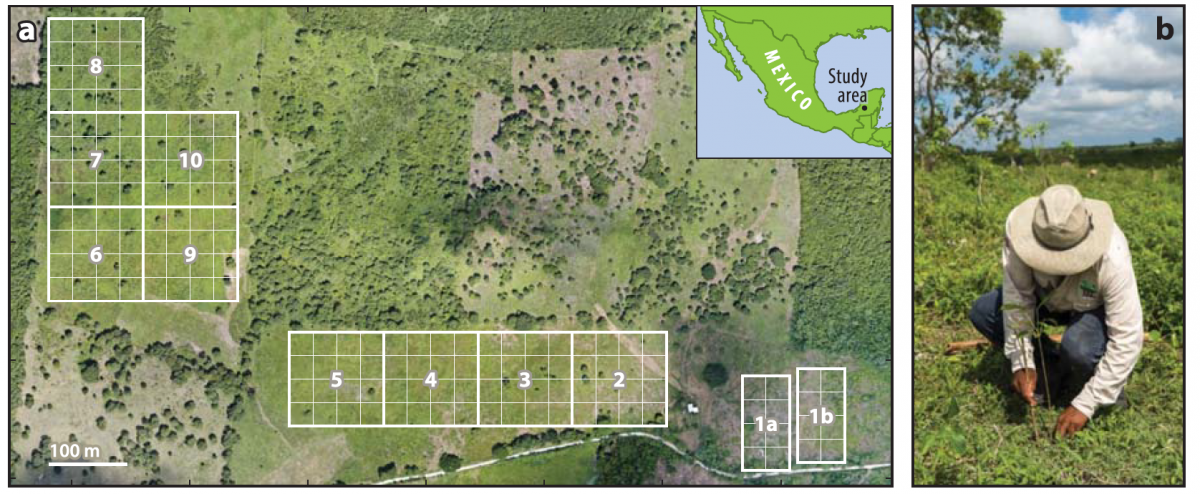 Facilitating reforestation through the plant microbiome: Perspectives from the Phyllosphere
Facilitating reforestation through the plant microbiome: Perspectives from the Phyllosphere
Can reforestation outcomes be improved by simultaneously introducing endophytes and other canopy microbes with tree plantings? Planting trees is a common way people attempt to mitigate the effects of climate change and to counteract the loss of native forest from land use change and plantings are more successful when soils are inoculated with symbiotic microorganisms. However, little research has been done to determine the impact of co-introducing beneficial canopy microbes such as fungal leaf endophytes. These endophytes can impact resilience, growth, development, and defense against pathogens. This paper attempts to determine whether enough evidence exists to incorporate aboveground and belowground microbiota into reforestation projects. Keywords: plant pathogens, endophytes, biodiversity, plant phyllosphere feedback, climate change, tree planting. Download PDF.
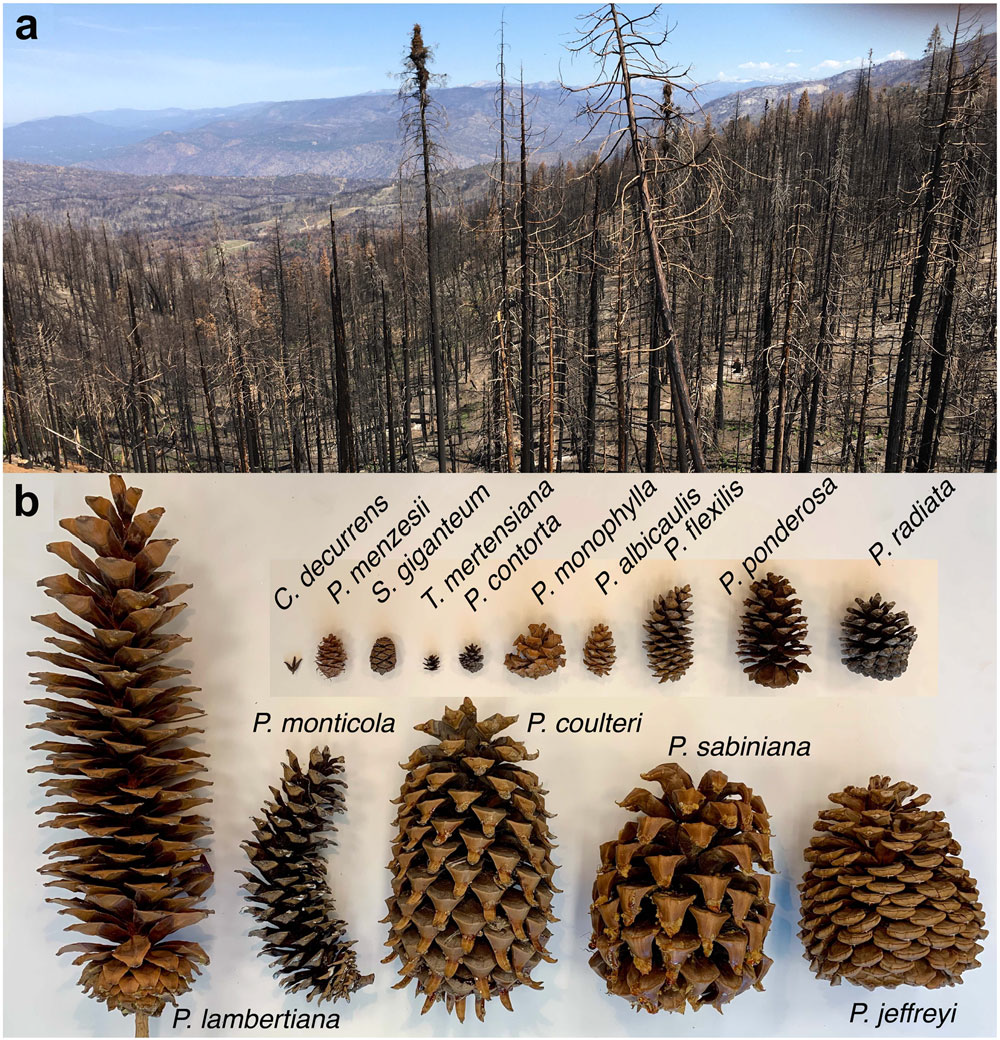 Limits to reproduction and seed size-number trade-offs that shape forest dominance and future recovery
Limits to reproduction and seed size-number trade-offs that shape forest dominance and future recovery
Is the number of tree seeds produced limited by the size of the seeds? Do some circumstances favor vegetative growth over reproduction? Are differences related to soil fertility? For recolonization after extreme weather events and disturbances, tree species depend on seed production and dispersal from surviving individuals. The authors evaluated whether species seed production (SSP) was constrained by a trade-off between the size and number of seeds produced, and whether SSP differences were related to resource allocation between growth/defense and seed production. They investigated whether individual standardized production increased with soil fertility and whether this depended on resource allocation differences. Finally, they examined whether community seed production was positively or negatively related to soil fertility. Keywords: tree species fecundity, seed size-number trade-offs, forest recovery, forest regeneration, individual standardized production, species seed production, community seed production, cation exchange capacity. Download PDF.
 Shifting stoichiometry: Long-term trends in stream-dissolved organic matter reveal altered C:N ratios due to history of atmospheric acid deposition
Shifting stoichiometry: Long-term trends in stream-dissolved organic matter reveal altered C:N ratios due to history of atmospheric acid deposition
What are long-term trends in dissolved organic carbon and nitrogen and do their ratios remain stable? For aquatic ecosystems, dissolved organic matter (DOM) is an important nutrient and energy source. Past work has assumed that changes in dissolved organic nitrogen and carbon (DON and DOC) are correlated. The authors performed a global study to determine long-term trends in DOC and DON in streams and rivers in the northern hemisphere across six biomes. They hypothesized that changes in DON would be positively correlated with DOC and that DOM stoichiometry (DOC:DON ratio) would remain stable. Keywords: atmospheric acid deposition, C:N stoichiometry, dissolved organic carbon, dissolved organic matter, dissolved organic nitrogen, long-term trends, streams. Download PDF.
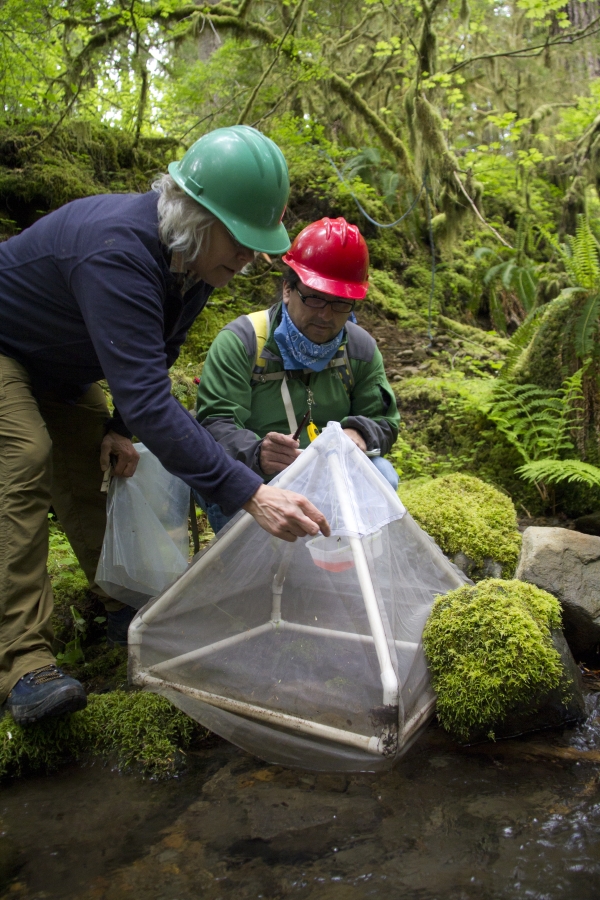 Spatiotemporal patterns of emergence phenology reveal complex species-specific responses to temperature in aquatic insects
Spatiotemporal patterns of emergence phenology reveal complex species-specific responses to temperature in aquatic insects
Can emergence duration and peak emergence date by predicted by calculating cumulative degree days or are there species-specific patterns that indicate more complex responses? The phenology, or timing, of adult stage emergence for aquatic insects is related to water temperature. A warming thermal regime resulting from global change may induce insects to emerge earlier potentially creating a mismatch with resources. Warming may also cause an extended emergence period, which may adaptively increase adult activity periods in productive years. The researchers studied four common spring-emerging aquatic insects to determine whether 1) adults emerged earlier and 2) the emergence period was longer in warmer streams and years. Keywords: aquatic insects, headwater streams, life history traits, phenology, temperature. Download PDF.
 Tree species diversity increases with conspecific negative density dependence across an elevation gradient
Tree species diversity increases with conspecific negative density dependence across an elevation gradient
How do conspecific density dependence (CDD) and heterospecific density dependence (HDD) affect tree species richness? Does the density of conspecifics have greater effects on survival and growth than the effects of having more neighbors in general, is CDD>HDD? The authors used CDD-HDD, which is a measure of conspecific suppression or facilitation, to determine whether conspecific density effects were more important in lower elevations with greater species diversity and in microclimates with greater humidity. Keywords: biodiversity, conspecifics, density dependence, elevational gradient, environment-diversity relationship, species interactions, conspecific negative density dependence, forest dynamics. Download PDF.
 UPRLIMET: Upstream Regional LiDAR Model for Extent of Trout in stream networks
UPRLIMET: Upstream Regional LiDAR Model for Extent of Trout in stream networks
What is the upper extent of fish distribution in Western Oregon streams and does this change across land ownership categories? Can scientists use LiDAR, which characterizes stream network hydrography more completely than other approaches, in combination with potential environmental predictor variables to create a model development and evaluation framework to determine the best predictor of trout (fish) distribution? Coastal Cutthroat Trout are often the uppermost fish in coastal Oregon streams and, therefore, the focus for distribution upper limit mapping. Sixty-seven predictor variables were also evaluated. Keywords: fish distribution, upper extent of fish, upper fish boundary, cutthroat trout, environmental DNA, novel model development and evaluation, LiDAR-based prediction model, logistic regression model, Fransen optimal model, Random Forest model, cross-boundary fish distribution map, landscape management, streams. Download PDF.
A 20-Year Ecotone Study of Pacific Northwest Mountain Forest Vulnerability to Changing Snow Conditions
How might tree species respond to a changing climate? Is there a natural scenario to study changes in tree populations on smaller spatial scales? In response to climate change species may shift their ranges poleward to remain within preferred climate niches. Similar migrations will occur upslope in mountains on smaller spatial scales. The authors investigated species movement on an elevation gradient using seedling growth patterns with snow cover as a climate change indicator. They determined whether snow cover and melt were associated with elevation, canopy cover, and decadal climate oscillations. The also examined whether tree seedlings were mixed, shifted to higher elevations, and responded to snowmelt patterns. Keywords: climate change, under-canopy seasonal snow cover, Pacific Decadal Oscillation, El Niño-Southern Oscillation, regeneration niche, western hemlock, Pacific silver fir. Download PDF.
Thirty years of forest productivity in a mountainous landscape: The Yin and Yang of topography
Can local-scale data be used to improve models of forest carbon storage, as measured by primary production? Do later-stage variables impact the amount of carbon stored in a forest? Forests are carbon sinks and regulate global climate. Understanding changes in carbon cycles after forest disturbance and recovery will improve predictive carbon sink models. The authors tested whether aboveground net primary productivity can be predicted by initial leaf area and topography and whether including later mortality and foliar nutrients measurements improved models. They also determined whether mortality impacted productivity in stands with different planting densities and whether light use efficiency and foliar nitrogen were related. Keywords: carbon, irradiation, light-use efficiency, LTER, mortality, mountains, plantations, thinning, thresholds, topography Download PDF.
Buried particulate organic C fuels heterotrophic metabolism in the hyporheic zone of a montane headwater stream
Is particulate organic carbon in the hyporheic zone more important for stream metabolism than stream-sourced dissolved organic carbon? In streams the hyporheic zone is the portion of subsurface sediments beneath and adjacent to streams where surface flow enters the subsurface and reemerges into surface flow downstream. This zone is an important area for carbon metabolism and cycling in streams. The researchers investigated whether heterotrophic metabolism in the hyporheic zone was fueled to a greater extent by dissolved organic carbon from surface-sourced flow or by particulate organic carbon that was buried or sediment-bound. Keywords: hyporheic, mesocosm, aerobic respiration, dissolved organic carbon, DOC, particulate organic carbon, POC, headwater stream. Download PDF.
Carbon-water tradeoffs in old-growth and young forests of the Pacific Northwest
Is there a tradeoff between water usage and carbon storage in Pacific Northwest forests? Do tradeoffs differ between young and mature forests? Forests are important for climate change adaptation and mitigation because of their carbon storage capacities. Land use history and forest age impact productivity, water and nutrient usage, and carbon storage potential. The authors attempt to develop landscape-scale reconstructions and predictions by combining tree growth data with long-term climate and streamflow data. They asked whether tree growth rates and forest variables differ among watersheds in a forest, and how forest history impacts both water use efficiency and which factors predict carbon-water tradeoffs. Keywords: Carbon-water tradeoffs, carbon storage, water use efficiency, basal area index, forest productivity, evapotranspiration, dry-season streamflow Download PDF.
Long-term changes in concentration and yield of riverine dissolved silicon from the poles to the tropics
What influences riverine silicon cycling and are there changes over time related to climate? Silicon availability in marine ecosystems supports diatom growth, which impacts the carbon cycle in marine and freshwater environments globally. Marine concentrations of silicon are mainly driven by terrestrial weathering and riverine transport. The amount of silicon exported by rivers is influenced by freshwater biotic uptake, vegetative uptake, and sedimentation. The authors investigated how changes in riverine silicon were related to land use or climate perturbations in 60 riverine ecosystems from the tropics to the polar regions. Keywords: dissolved silicon, riverine silicon flux, silicon cycling, river silicon biogeochemistry, biome-specific river silicon exports. Download PDF.
Watershed responses to climate change-driven disturbances in temperate montane ecosystems of the Western United States
Will mountain forest disturbances and thus watershed characteristics be impacted by climate change and can we use stream hydrology and chemistry to identify these impacts? Watershed hydrology and vegetation dynamics will be impacted by changes in climate, which will likely cause decreased snowpack, earlier snowmelt, earlier peak streamflow, and increased evaporation, as well as increased frequency of large-scale disturbances. Stream waters are indicators of upstream conditions over multiple spatial and temporal scales. The authors present a conceptual framework combining hydrography and chemography to study watersheds and their reactions to 4 disturbances: precipitation snow to rain transition, vegetation shifts, wildfire, and insect outbreaks. Keywords: hydrograph, chemograph, hydro-chemograph, hydrology, biogeochemistry, climate change, disturbance, vegetation change, wildfire, insect outbreak. Download PDF.
Beyond the case study: Characterizing natural floodplain heterogeneity in the United States
How natural floodplains controlled? What factors influence their creation and maintenance? The authors quantify floodplain heterogeneity in 15 floodplains of various sizes across the continental United States to determine how fluvial and ecological processes create and maintain natural floodplains. They assessed whether river corridor characteristics can predict floodplain heterogeneity and assumed that the main factors controlling floodplain heterogeneity are lateral space availability and lateral channel mobility. They define floodplain heterogeneity as spatial variation in geomorphic features and vegetative communities and the patchiness of this variation. Keywords: floodplain heterogeneity, channel planform, floodplain/channel width ratio, floodplain evenness, floodplain aggregation, floodplain density, floodplain interspersion. Download PDF.
Barred Owl predation of Western Spotted Skunks
Do invasive barred owls prey on western spotted skunks, a small native forest carnivore? Western spotted skunks (Spilogale gracilis) are small mostly nocturnal carnivores in Pacific Northwest forests. With low population densities and reproductive effort, their populations are sensitive to changes in predation. Barred owls (Strix varia) have invaded Pacific Northwest forests through natural range expansion and their densities are often higher than the native owls they displaced. As part of a larger study on western spotted skunks in the Willamette Forest, the researchers attempted to gather evidence of barred owl predation on western spotted skunks. Keywords: DNA metabarcoding, HJ Andrews Experimental Forest, mortality, Oregon, Spilogale gracilis, Strix varia, Willamette National Forest. Download PDF.
Advancing the science of headwater streamflow for global water protection
What level of understanding do we have of headwater streams? How can we improve both our understanding and our management? Headwater streams are often overlooked components of watersheds globally and are generally unprotected. Headwater streamflow is variable, covers broad areas, and may be seasonal, intermittent, or ephemeral. The authors argue that creating a global understanding of headwater systems and flow regimes across space and time will support better management. They propose uniform definitions for headwater systems, summarize their regulatory status, synthesize the ways data and modelling are used to characterized headwater streamflow across space and time, and suggest new approaches for understanding and describing headwaters. Keywords: headwater stream, headwater classification, watershed resiliency, headwater definition, headwater protection. Download PDF.
The streamwater microbiome encodes hydrologic data across scales
Can the microbiome of streamwater be used to investigate hydrology? Can studying microbial taxonomy and abundance provide insight into hydrologic characteristics of a watershed? Researchers investigated whether patterns in stream microbial communities can be used to investigate and understand stream hydrology. Microbial community composition has been associated with stream scale and landscape scale spatial characteristics and geomorphology, which are related to hydrologic function. To determine if microbiomes can be used to study open questions in hydrology, the scientists analyzed taxonomic composition of the microbial community along with hydrological metrics that are used to describe watershed hydrology and water balance characteristics. Keywords: watershed hydrology, 16S metabarcoding, information theory, mutual information, Pacific Northwest. Download PDF.
Globally, tree fecundity exceeds productivity gradients
Why might tree fecundity differ over a latitudinal gradient? What processes might be driving fecundity differences? The authors investigated whether tree fecundity varied with latitude. A previous study indicated that seed mass density is higher in the tropics and decreases with latitude. In the current study, the researchers investigated whether seed mass in the tropics was higher because trees in the tropics are larger and therefore produce more seeds, or because trees of a given size produce more seeds in warmer wetter areas. They quantified seed production by tree and unit area to examine individual and community fecundity. Keywords: climate, competition, forest regeneration, seed consumption, species interactions, tree fecundity. Download PDF.
